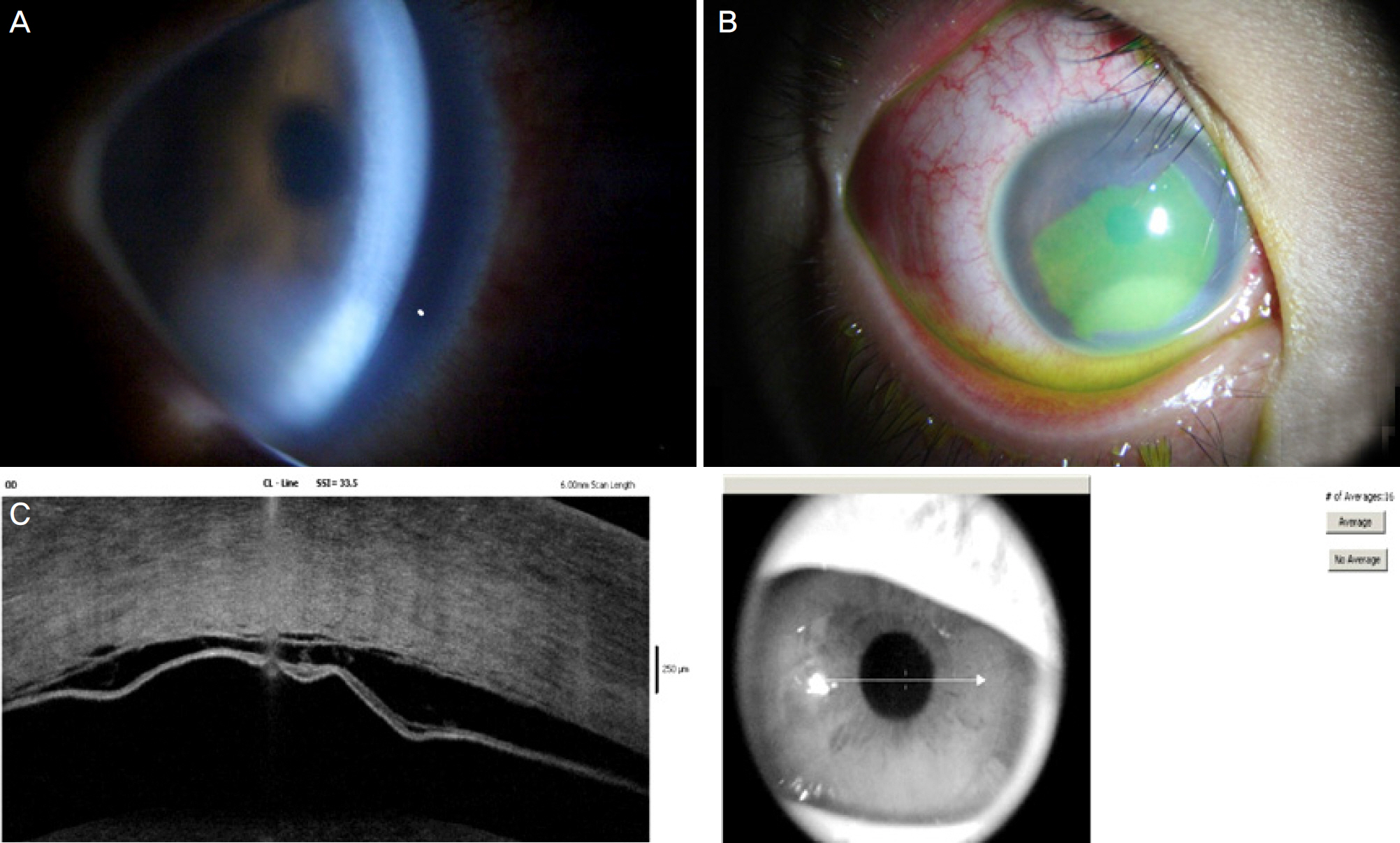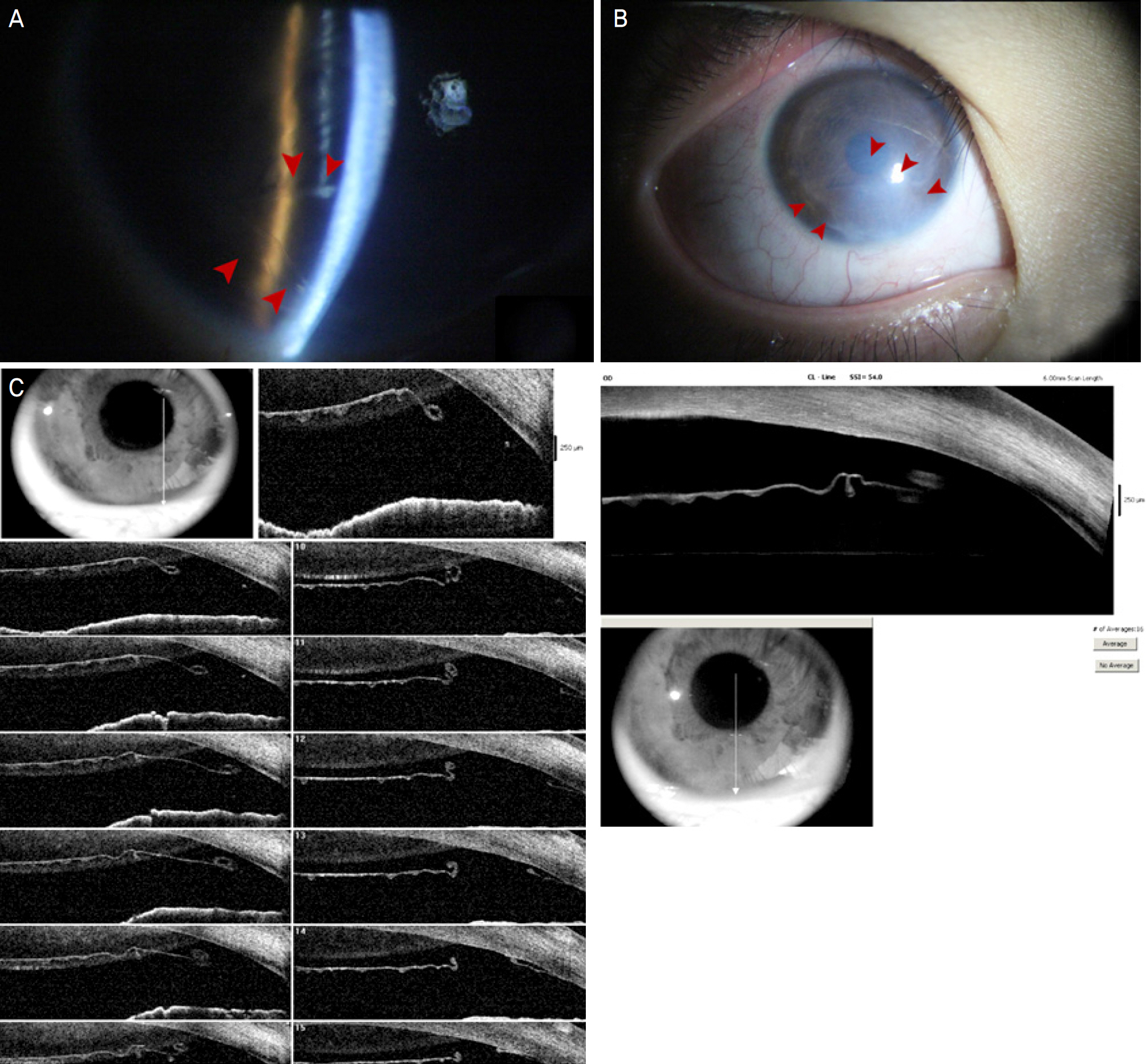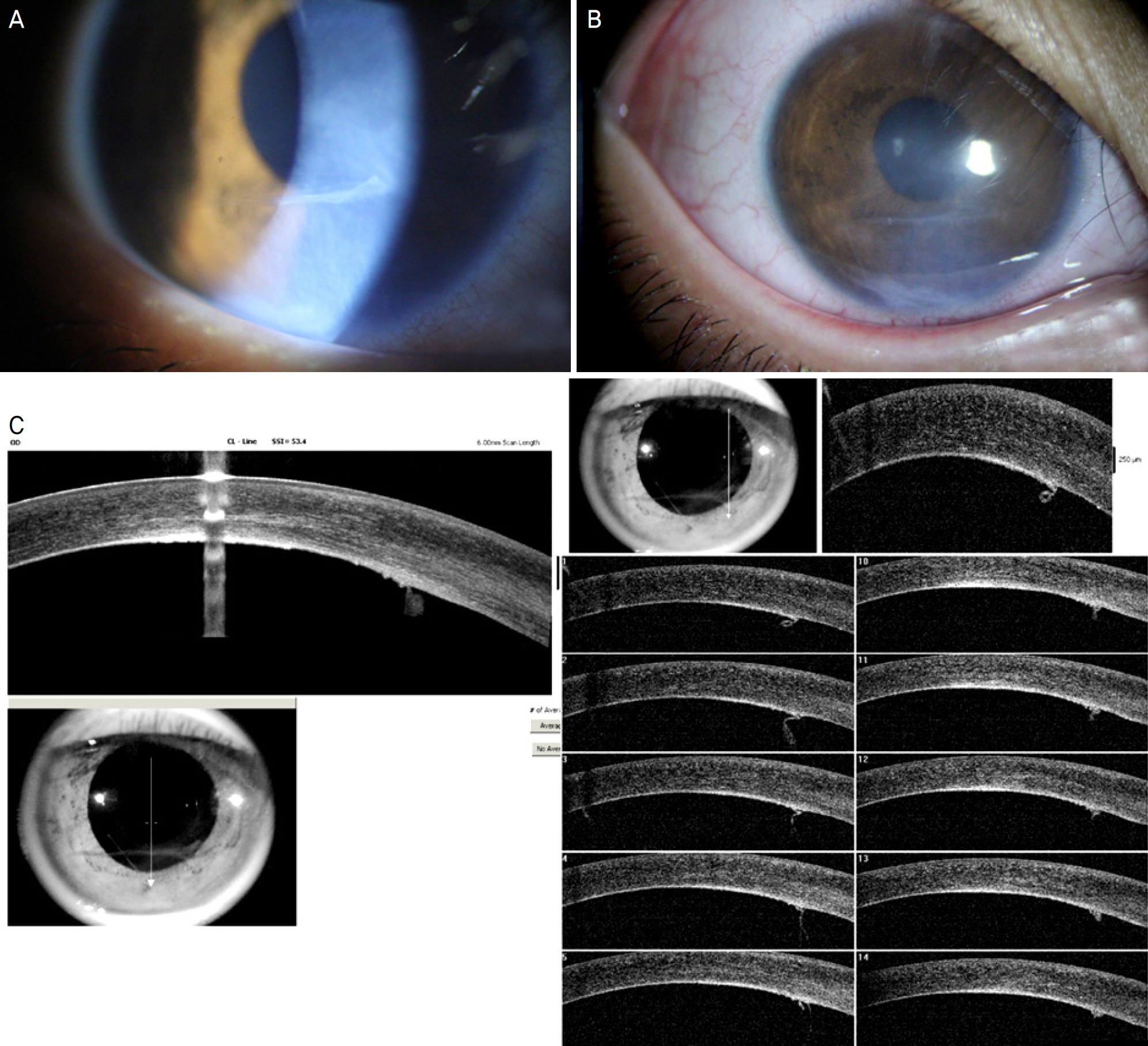J Korean Ophthalmol Soc.
2016 Nov;57(11):1790-1794. 10.3341/jkos.2016.57.11.1790.
A Case of Descemet's Membrane Detachment during Lidocaine Injection for Hordeolum Incision and Drainage
- Affiliations
-
- 1The Institute of Vision Research, Department of Ophthalmology, Yonsei University College of Medicine, Seoul, Korea. TIKIM@yuhs.ac
- 2Corneal Dystrophy Research Institute, Department of Ophthalmology, Yonsei University College of Medicine, Seoul, Korea.
- KMID: 2357738
- DOI: http://doi.org/10.3341/jkos.2016.57.11.1790
Abstract
- PURPOSE
To report a case of Descemet's membrane detachment and corneal edema caused by an iatrogenic corneal perforation created while performing a local anesthetic (lidocaine) injection into the eyelid for a hordeolum incision and a drainage procedure. The detachment resolved after 14% C₃F₈ gas and air injections into the anterior chamber.
CASE SUMMARY
An 8-year-old female visited our clinic after the onset of severe pain and decreased visual acuity while receiving a local anesthetic injection into the upper eyelid in preparation for a hordeolum incision and drainage procedure. Corneal optical coherence tomography (OCT) showed Descemet's membrane detachment. Three days after the first visit, the corneal epithelium had entirely healed. However, Descemet's membrane detachment persisted even after three weeks of follow-up. A corneal OCT was repeated after three weeks and showed a partial Descemet's membrane rupture. A more aggressive treatment method was deemed necessary, and gas and air injections into the anterior chamber were performed. After 48 hours, aside from some Descemet's membrane rolling at the site of rupture, overall reattachment of Descemet's membrane was noted. After three months of follow-up, the patient showed a stable corneal state and normalized vision.
CONCLUSIONS
Descemet's membrane detachment and rupture resulting from an iatrogenic corneal perforation during an injection of lidocaine to the eyelid led to decreased visual acuity from corneal edema. As a more aggressive treatment method, 14 % C₃F₈ gas and air injections into the anterior chamber were performed and resulted in near complete reattachment of Descemet's membrane's and normalization of the patient's visual acuity.
Keyword
MeSH Terms
Figure
Cited by 1 articles
-
Corneal Stromal Edema during Lidocaine Injection for Blepharoplasty
Sung Yeon Jun, Yeon Jung Choi, Young Joo Cho
J Korean Ophthalmol Soc. 2019;60(10):994-998. doi: 10.3341/jkos.2019.60.10.994.
Reference
-
References
1. Iradier MT, Moreno E, Aranguez C, et al. Late spontaneous abdominal of a massive detachment of Descemet's membrane after phacoemulsification. J Cataract Refract Surg. 2002; 28:1071–3.2. Minkovitz JB, Schrenk LC, Pepose JS. Spontaneous resolution of an extensive detachment of Descemet's membrane following phacoemulsification. Arch Ophthalmol. 1994; 112:551–2.
Article3. Ghosh S, Mukhopadhyay S, Mukhopadhyay S, et al. Inadvertent intracorneal injection of local anesthetic during lid surgery. Cornea. 2010; 29:701–2.
Article4. Schellini SA, Creppe MC, Grego'rio EA, Padovani CR. Lidocaine effects on corneal endothelial cell ultrastructure. Vet Ophthalmol. 2007; 10:239–44.
Article5. Rosenwasser GO. Complications of topical ocular anesthetics. Int Ophthalmol Clin. 1989; 29:153–8.
Article6. Britton B, Hervey R, Kasten K, et al. Intraocular irritation evaluation of benzalkonium chloride in rabbits. Ophthalmic Surg. 1976; 7:46–55.
Article7. Najjar DM, Rapuano CJ, Cohen EJ. Descemet membrane abdominal with hemorrhage after alkali burn to the cornea. Am J Ophthalmol. 2004; 137:185–7.8. Liu DT, Lai JS, Lam DS. Descemet membrane detachment after abdominal argon-neodymium: YAG laser peripheral iridotomy. Am J Ophthalmol. 2002; 134:621–2.9. Lee SE, Cho KJ, Cho WH, et al. Spontaneous reattachment of Descmet's membrane detachment at postoperative two months, which occurred during cataract surgery. J Korean Ophthalmol Soc. 2013; 54:351–6.10. Koh JW, Woon WJ, Na KS. A case of total Desmet's Nembrane abdominal treated by non-expansible SF6 gas infusion. J Korean Ophthalmol Soc. 2002; 43:2598–602.11. Hoover DL, Giangiacomo J, Benson RL. Descemet's membrane detachment by sodium hyaluronate. Arch Ophthalmol. 1985; 103:805–8.
Article12. Assia EI, Levkovich-Verbin H, Blumenthal M. Management of Descemet's membrane detachment. J Cataract Refract Surg. 1995; 21:714–7.
Article13. Kim T, Sorenson A. Bilateral Descemet membrane detachments. Arch Ophthalmol. 2000; 118:1302–3.
Article14. Macsai MS, Grainer KM, Chisholm L. Repair of Descemet''s membrane detachment with perfluoropropane (C3F8). Cornea. 1998; 17:129–34.
Article15. Shah M, Bathia J, Kothari K. Repair of late Descemet''s membrane detachment with perfluoropropane gas. J Cataract Refract Surg. 2003; 29:1242–4.
Article
- Full Text Links
- Actions
-
Cited
- CITED
-
- Close
- Share
- Similar articles
-
- Descemet's Membrane Detachment Associated with Inadvertent Viscoelastic Injection in Viscocanalostomy
- A Case of Spontaneous Detachment of Descemet's Membrane
- Spontaneous Reattachment of Descemet's Membrane Detachment at Postoperative Two Months, Which Occurred During Cataract Surgery
- Three Cases of Descemet's Membrane Detachment after Cataract Surgery
- Descemet's Membrane Detachment during 360 degreesTrabeculotomy




